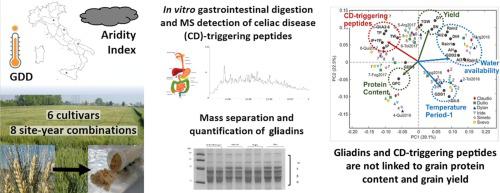当前位置:
X-MOL 学术
›
Eur. J. Agron.
›
论文详情
Our official English website, www.x-mol.net, welcomes your
feedback! (Note: you will need to create a separate account there.)
Influence of environmental and genetic factors on content of toxic and immunogenic wheat gluten peptides
European Journal of Agronomy ( IF 4.5 ) Pub Date : 2020-08-01 , DOI: 10.1016/j.eja.2020.126091 Domenico Ronga , Luca Laviano , Marcello Catellani , Justyna Milc , Barbara Prandi , Fatma Boukid , Stefano Sforza , Arnaldo Dossena , Sara Graziano , Mariolina Gullì , Giovanna Visioli , Nelson Marmiroli , Pasquale De Vita , Nicola Pecchioni , Enrico Francia
European Journal of Agronomy ( IF 4.5 ) Pub Date : 2020-08-01 , DOI: 10.1016/j.eja.2020.126091 Domenico Ronga , Luca Laviano , Marcello Catellani , Justyna Milc , Barbara Prandi , Fatma Boukid , Stefano Sforza , Arnaldo Dossena , Sara Graziano , Mariolina Gullì , Giovanna Visioli , Nelson Marmiroli , Pasquale De Vita , Nicola Pecchioni , Enrico Francia

|
Abstract The impact of environment, genetic selection and their interactions on grain yield of durum wheat genotypes has been extensively studied; however, limited information is available for their influence on gluten quality associated with effects on the amount and composition of glutenins, gliadins and celiac disease (CD)-triggering peptides. In this study, a set of six commonly cultivated durum wheat genotypes were assessed in a multi-environment trial of eight site-year combinations in different Italian regions during two consecutive harvest years (2016 and 2017). While high-molecular-weight glutenin subunits (HMW-GS) were more stable between years, differences in total gluten proteins were mainly due to low-molecular-weight glutenin subunits (LMW-GS) and gliadins accumulation. After mass separation and quantification, two gliadin proteins – γ-Gli-5 and α-GliA2-6 (41.1 and 33.8 kDa, respectively) – were further studied together with toxic (TP) and immunogenic (IP) celiac disease-triggering peptides obtained via simulated gastrointestinal digestion. While TP accumulation was strongly influenced by the genotypes, IP showed marked variation in the different sites with significant genotype-by-year and genotype-by-site interaction. Specific agrometeorological variables (i.e. growing degree days and aridity index) in different growing phases showed a strong negative correlation with α-GliA2-6 and CD-associated peptides. Statistical analysis revealed that the level of gliadins and TP/IP peptides were uncorrelated with grain protein content and yield. The selection of plant materials with good technological properties but with a low content of CD-triggering peptides should combine with ad hoc environment (e.g. site) selection and management practices reducing crop evapotranspiration in the vegetative phase.
中文翻译:

环境和遗传因素对有毒和免疫原性小麦面筋肽含量的影响
摘要 环境、遗传选择及其相互作用对硬粒小麦基因型籽粒产量的影响已得到广泛研究;然而,关于它们对谷蛋白质量的影响的信息有限,这些信息与谷蛋白、麦胶蛋白和乳糜泻 (CD) 触发肽的数量和组成有关。在这项研究中,在连续两个收获年(2016 年和 2017 年)期间,在意大利不同地区的八种地点年份组合的多环境试验中,对一组六种常见的硬质小麦基因型进行了评估。虽然高分子量麦谷蛋白亚基 (HMW-GS) 在年份之间更稳定,但总面筋蛋白的差异主要是由于低分子量麦谷蛋白亚基 (LMW-GS) 和麦胶蛋白的积累。质量分离和定量后,两种麦醇溶蛋白——γ-Gli-5 和 α-GliA2-6(分别为 41.1 和 33.8 kDa)——与通过模拟胃肠道消化获得的毒性 (TP) 和免疫原性 (IP) 乳糜泻触发肽一起进一步研究。虽然 TP 积累受基因型的强烈影响,但 IP 在不同位点显示出显着的变异,具有显着的逐年基因型和逐位基因型相互作用。不同生长阶段的特定农业气象变量(即生长期天数和干旱指数)与α-GliA2-6和CD相关肽呈强烈负相关。统计分析表明,麦醇溶蛋白和 TP/IP 肽的水平与谷物蛋白质含量和产量无关。
更新日期:2020-08-01
中文翻译:

环境和遗传因素对有毒和免疫原性小麦面筋肽含量的影响
摘要 环境、遗传选择及其相互作用对硬粒小麦基因型籽粒产量的影响已得到广泛研究;然而,关于它们对谷蛋白质量的影响的信息有限,这些信息与谷蛋白、麦胶蛋白和乳糜泻 (CD) 触发肽的数量和组成有关。在这项研究中,在连续两个收获年(2016 年和 2017 年)期间,在意大利不同地区的八种地点年份组合的多环境试验中,对一组六种常见的硬质小麦基因型进行了评估。虽然高分子量麦谷蛋白亚基 (HMW-GS) 在年份之间更稳定,但总面筋蛋白的差异主要是由于低分子量麦谷蛋白亚基 (LMW-GS) 和麦胶蛋白的积累。质量分离和定量后,两种麦醇溶蛋白——γ-Gli-5 和 α-GliA2-6(分别为 41.1 和 33.8 kDa)——与通过模拟胃肠道消化获得的毒性 (TP) 和免疫原性 (IP) 乳糜泻触发肽一起进一步研究。虽然 TP 积累受基因型的强烈影响,但 IP 在不同位点显示出显着的变异,具有显着的逐年基因型和逐位基因型相互作用。不同生长阶段的特定农业气象变量(即生长期天数和干旱指数)与α-GliA2-6和CD相关肽呈强烈负相关。统计分析表明,麦醇溶蛋白和 TP/IP 肽的水平与谷物蛋白质含量和产量无关。











































 京公网安备 11010802027423号
京公网安备 11010802027423号